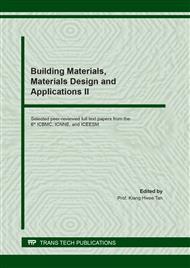[1]
Chen S. Structural design, mechanism and application of hyperbranched polymers[D]: University of Science and Technology of China (In Chinese with English abstract); (2016).
Google Scholar
[2]
Flory PJ. Molecular Size Distribution in Three Dimensional Polymers. VI. Branched Polymers Containing A—R—Bf-1 Type Units. Journal of the American Chemical Society. 1952;74(11).
DOI: 10.1021/ja01131a008
Google Scholar
[3]
Kim YH, Webster OW. Hyperbranched polyphenylenes. Macromolecules. 1992;25(21):5561-72.
DOI: 10.1021/ma00047a001
Google Scholar
[4]
Martinez-Garcia M, Kormpa A, van der Maarel MJEC. The glycogen of Galdieria sulphuraria as alternative to starch for the production of slowly digestible and resistant glucose polymers. Carbohydrate Polymers. 2017;169:75-82.
DOI: 10.1016/j.carbpol.2017.04.004
Google Scholar
[5]
Lee SB, Ha DI, Cho SK, Kim SJ, Lee YM. Temperature/pH‐sensitive comb‐type graft hydrogels composed of chitosan and poly(N‐isopropylacrylamide). Journal of Applied Polymer Science. 2010;92(4):2612-20.
DOI: 10.1002/app.20265
Google Scholar
[6]
Xing A, Sun Q, Meng Y, Zhang Y, Han B. A hydroxyl-containing hyperbranched polymer as a multi-purpose modifier for a dental epoxy. Reactive and Functional Polymers. 2020;149:104505-.
DOI: 10.1016/j.reactfunctpolym.2020.104505
Google Scholar
[7]
Li W. Expression and identification of recombinant adenovirus mediated macaca mulatta PD-L1Ig and CD40L extracellular region gene in mulatta immature dendritic cells: Kunming Medical University; (2015).
Google Scholar
[8]
Xu T. Fabrication of 3D-printed PLGA hybrid scaffolds for tissue engineering: East China University of Science and Technology; (2015).
Google Scholar
[9]
Asif A, Huang C, Shi W. Structure–property study of waterborne, polyurethane acrylate dispersions based on hyperbranched aliphatic polyester for UV-curable coatings. Colloid and Polymer Science. 2004;283(2):200-8.
DOI: 10.1007/s00396-004-1123-2
Google Scholar
[10]
Samuelsson J, Sundell PE, Johansson M. Synthesis and polymerization of a radiation curable hyperbranched resin based on epoxy functional fatty acids. Progress in Organic Coatings. 2004;50(3):193-8.
DOI: 10.1016/j.porgcoat.2004.02.005
Google Scholar
[11]
Wang Z, Tong S. Synthesis and characterization of hyperbranched polyester amide polymers for coatings. Paint & Coatings Industry. 2005(11):9-12+70 (In Chinese with English abstract).
Google Scholar
[12]
Tsubokawa N, Hayashi S, Nishimura J. Grafting of hyperbranched polymers onto ultrafine silica: postgraft polymerization of vinyl monomers initiated by pendant initiating groups of polymer chains grafted onto the surface. Progress in Organic Coatings. 2002;46(2):193-201.
DOI: 10.1016/s0300-9440(01)00252-1
Google Scholar
[13]
Itoh T, Horii S, Hashimoto S, Uno T, Kubo M. Polymer electrolytes plasticized with hyperbranched polymer for lithium polymer batteries. Ionics. 2004;10(5-6):450-7.
DOI: 10.1007/bf02378007
Google Scholar
[14]
Xiao W, Hu J, Xu W. Advance in synthesis and applications of hyperbranched polymers. Chemical Industry and Engineering Progress. 2007(09):1253-7 (In Chinese with English abstract).
Google Scholar
[15]
Wang H, Pu X. The Structure and Properties of a Novel Hydroxyl‐Terminated Hyperbranched Polymer for Inhibiting Shale Hydration. ChemistrySelect. 2019;4(38).
DOI: 10.1002/slct.201902524
Google Scholar
[16]
Zhou C. Progress in synthesis and application of new hyperbranched polymers. China Rubber/Plastics Technology and Equipment(In Chinese with English Abstract). 2019(14):10.
Google Scholar
[17]
Sun P. Preparation and Properties of Polylactic acid-based Biomedical Composites Changchun University of Technology; (2019).
Google Scholar
[18]
Rothen-Weinhold A, Besseghir K, Vuaridel E, Sublet E, Oudry N, Kubel F, et al. Injection-molding versus extrusion as manufacturing technique for the preparation of biodegradable implants. European journal of pharmaceutics and biopharmaceutics. 1999;48(2):113-21.
DOI: 10.1016/s0939-6411(99)00034-x
Google Scholar
[19]
Tchernof A, Bélanger C, Morisset A-S, Richard C, Mailloux J, Laberge P, et al. Regional differences in adipose tissue metabolism in women: minor effect of obesity and body fat distribution. Diabetes. 2006;55(5):1353-60.
DOI: 10.2337/db05-1439
Google Scholar
[20]
Lei Z, Bai Y, Wang S. Synthesis of high molecular weight polylactic acid from aqueous lactic acid co-catalyzed by tin (II) chloride dihydrate and succinic anhydride. Chinese Science Bulletin. 2005;50(20):2390-2.
DOI: 10.1360/982005-1208
Google Scholar
[21]
Zhao Y, Wang Z, Wang J, Mai H, Yan B, Yang F. Direct synthesis of poly (D, L‐lactic acid) by melt polycondensation and its application in drug delivery. Journal of applied polymer science. 2004;91(4):2143-50.
DOI: 10.1002/app.13354
Google Scholar
[22]
Ren Z, Lu D, Zhou T, Lei Z. Synthesis of Degradable Hyperbranched Poly (lactic Acid) by Melt Polycondesation. Journal of Lanzhou Jiaotong University (In Chinese with English abstract) 2008;27(1):164-8.
Google Scholar
[23]
Coady DJ, Engler AC, Horn HW, Bajjuri KM, Fukushima K, Jones GO, et al. Catalyst chelation effects in organocatalyzed ring-opening polymerization of lactide. ACS Macro Letters. 2012;1(1):19-22.
DOI: 10.1021/mz2000048
Google Scholar
[24]
Persson PV, Casas J, Iversen T, Córdova A. Direct Organocatalytic Chemoselective Synthesis of a Dendrimer-like Star Polyester. Macromolecules. 2006;39(8):2819-22.
DOI: 10.1021/ma0521710
Google Scholar
[25]
Parzuchowski PG, Stefańska M, Świderska A, Roguszewska M, Zybert M. Hyperbranched polyglycerols containing amine groups—Synthesis, characterization and carbon dioxide capture. Journal of CO2 Utilization. 2018;27:145-60.
DOI: 10.1016/j.jcou.2018.07.010
Google Scholar
[26]
Shi W, Huang H. Progress in Hyperbranched Polymers. Chemical Journal of Chinese Universities (In Chinese with English abstract). 1997(08):1398-405 (In Chinese with English abstract).
Google Scholar
[27]
Bourissou D, Martin-Vaca B, Dumitrescu A, Graullier M, Lacombe F. Controlled Cationic Polymerization of Lactide. Macromolecules. 2005;38(24):9993-8.
DOI: 10.1021/ma051646k
Google Scholar
[28]
Shen X, Xiao N, Li J. The synthesis and analysis of PLLA. Applied Science and Technology. 2008;035(012):54-9 (In Chinese with English abstract).
Google Scholar
[29]
Liu H, Wang X, Zhang L. Synthesis of High Molecular Weight Poly Lactic Acid by Lactide Ring-opening Polymerization. Guangzhou Chemical Industry (In Chinese with English abstract). 2015;43(16):123-6+89(In Chinese with English abstract).
Google Scholar
[30]
Burillo G, Castillo-Rojas S, Arrieta H. Cu (II) immobilization in AAc/NIPAAm-based polymer systems synthesized using ionizing radiation. Radiation Physics and Chemistry. 2012;81(3):278-83.
DOI: 10.1016/j.radphyschem.2011.11.010
Google Scholar
[31]
Qin X, Chen Y. Research progress in synthesis and application of hyperbranched polymers. New chemical materials. 2020;48(7):6-10.
Google Scholar


